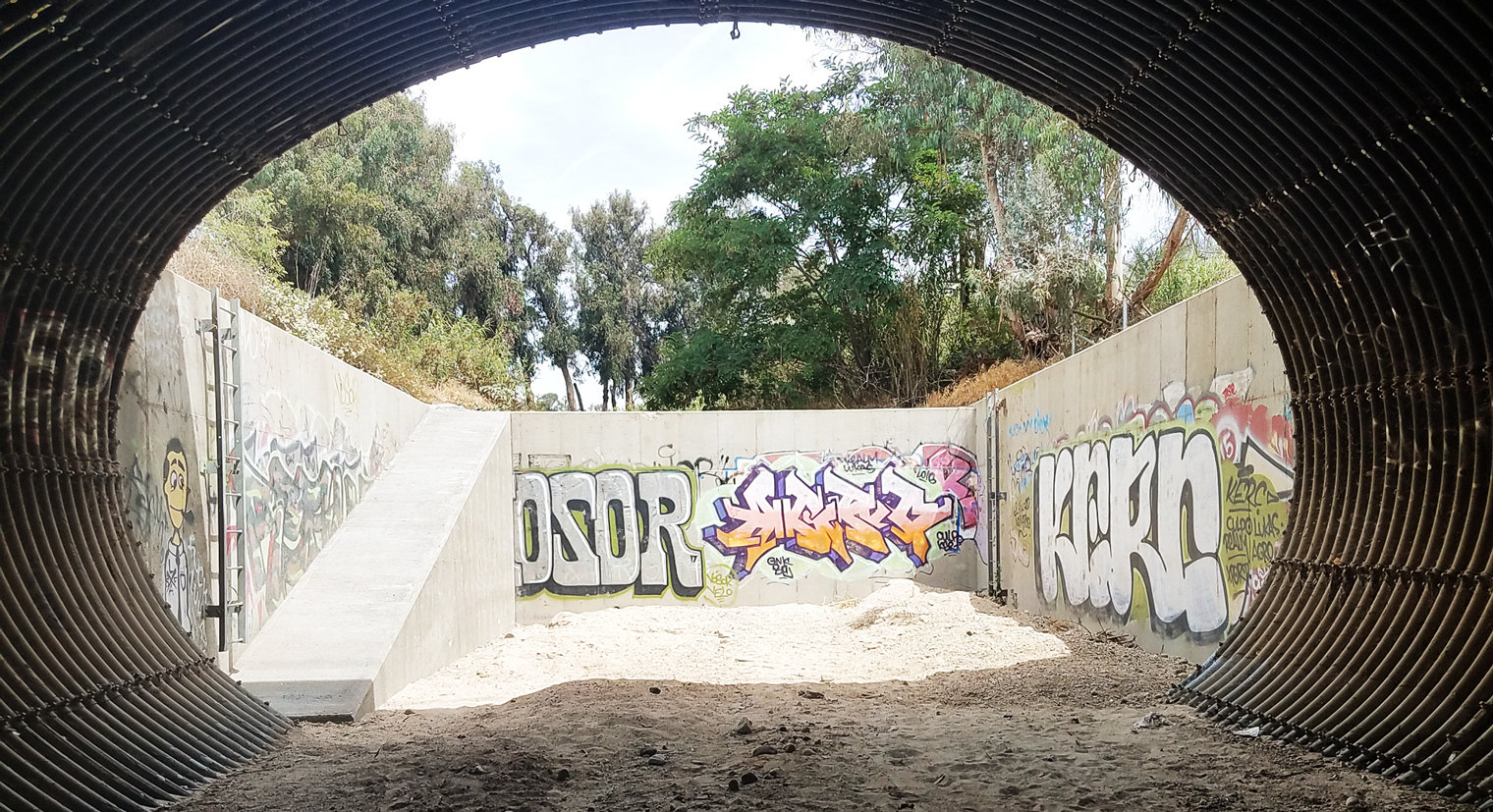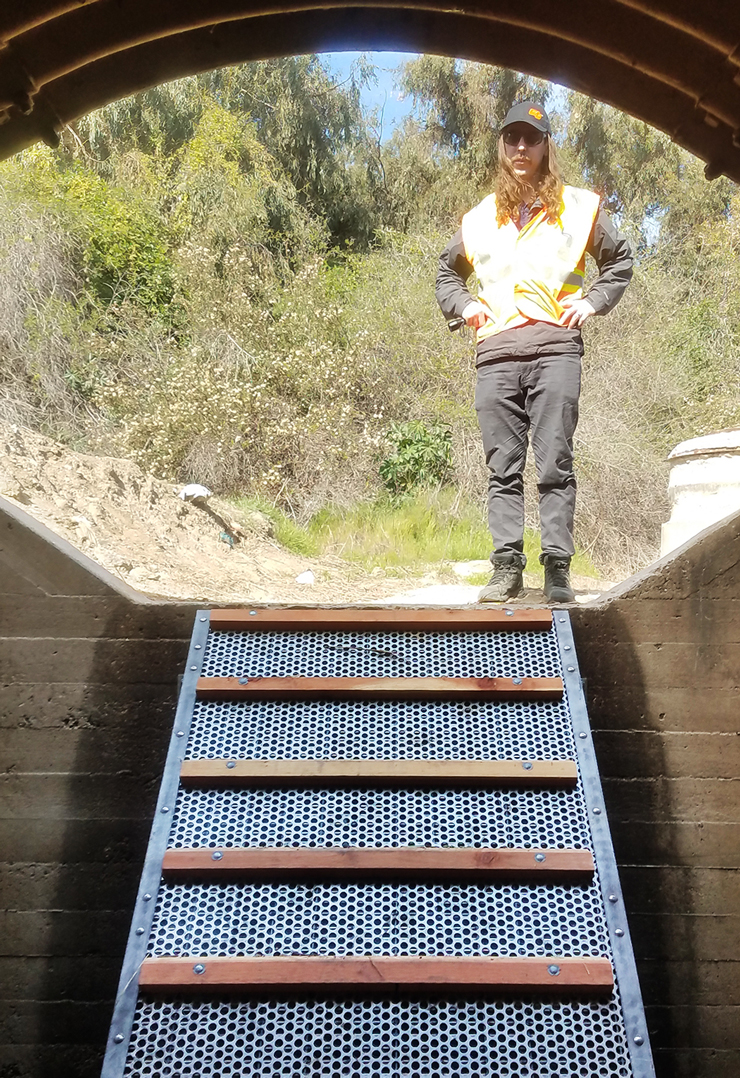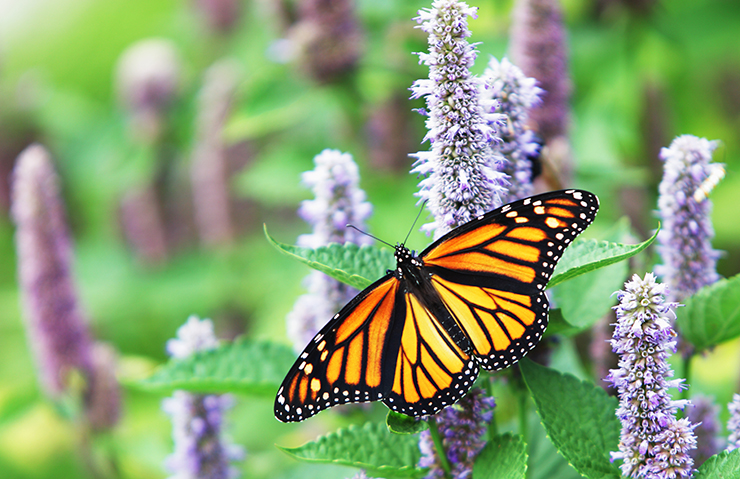Safety Concerns Extend to Our Animal Friends, Too
Caltrans Creates Safer Passages for Wildlife in State Highway Zones

Mountain lions, opossums, frogs and butterflies are some of the species that Caltrans is going to great lengths to preserve and protect along the state’s highway network. Here are some of those wildlife projects:
Frog ladder/tube along SR 70, District 3
The November 2018 Camp Fire devastated the town of Paradise, consumed some 70,000 acres, and left many of the area’s state-maintained roadways with clogged or damaged culverts. Caltrans crews repaired and replaced as many culverts as it could, as quickly as possible, to keep the roadways open from stormwater runoff and debris flows.
In June 2019, the U.S. Forest Service told Caltrans that it had found two adult female foothill yellow-legged frogs in a drainage inlet in the Feather River Canyon that were unable to access their upstream habitat. The foothill yellow-legged frogs have been protected by the California Endangered Species Act since late 2019.
The drainage inlet where the frogs were stranded was located at postmile 47.07 along State Route 70 near the Butte-Plumas County line. Many tributaries trickle down the hillside and pass under this stretch of the roadway, then continue flowing into the North Fork Feather River, an important breeding ground for the foothill yellow-legged frog. The river meets the frog’s breeding needs in terms of substrate, flow requirements, amount of light, and temperature.
Originally an open-pipe culvert with an L-shaped design that allowed frogs to go upstream, this drainage was converted into a graded drainage inlet after the Camp Fire that prevented the animals from accessing upstream habitat. This frog species cannot climb smooth, wet vertical surfaces, so it could not get out of the new inlet.
Because Caltrans prioritizes wildlife welfare in its construction and maintenance operations, an environmental and hydraulics design team joined forces to solve the problem. Caltrans, working with the Forest Service and California Department of Fish and Wildlife, determined that a design solution needed six features: It had to be built and adjusted quickly, be easy to install, have traction for a claw-like feet, be environmentally friendly, and have a long lifespan and low maintenance costs.
The resulting “NMH” frog tube — named after District 3 hydraulics engineer Jesse Gilbert’s three children, Nolan, Myra and Harmony — met those requirements. Materials were purchased at a hardware store and the ladder was constructed in the field. Soon, pictures taken by cameras placed in the passages showed frogs using the ladder. Months later, Caltrans installed the permanent frog tube and a mounted camera monitors wildlife activity.
An NMH frog ladder also has been installed at SR 70’s postmile 46.07.
SR 118 crossings in Ventura County, District 7

State Route 118 in Ventura County has posed one of the largest obstacles to wildlife movement within the Santa Monica-Sierra Madre Connection, which links the coastal Santa Monica Mountains with the Santa Susana Mountains and the Sierra Madre Ranges of Los Padres National Forest.
With a grant from the California Natural Resources Agency, Caltrans addressed wildlife access problems at five wildlife-crossing locations of SR 118 in the Las Posas Valley.
Work on the project began almost a decade ago. In 2011 to 2013, with help from the National Park Service, Caltrans conducted a 22-month wildlife-mortality study of a 12.3-mile stretch from west of Somis to Moorpark. On average, the study found, 1.35 animals were killed every day. Rabbits, opossums and California ground squirrels were the most prevalent species killed by vehicles.
In all, the study identified seven key culvert crossings. Three underpasses on SR 118 accounted for 97 percent of the documented crossings by animals. These culvert crossings, the study determined, had walls that hindered animals’ efforts to cross.
Caltrans and Park Service representatives met with the Federal Highway Administration, which provided alternatives for retrofitting culverts that would accommodate medium to large predatory animals such as bobcats, coyotes and mountain lions.
Caltrans and its partners in this project were awarded a $349,600 state grant. Fences and ramps were installed to increase safe wildlife passage, and $18,000 was set aside for National Park Service wildlife biologists for a post-construction follow-up.
The project is expected to preserve ecosystems, increase genetic diversity of populations that can more safely travel between the parklands, and increase wildlife’s access to resources. By directing animals safely underneath highways, collisions with motorists also should be reduced.
Liberty Canyon Wildlife Crossing, District 7

As was the case with other highway developments of the time, wildlife crossings and habitat were not incorporated into the planning of US 101 when it was commissioned in 1926. The stretch near Malibu Canyon separated the Santa Monica Mountains in Los Angeles County and the Santa Susana Mountains in Ventura County. These ranges connect to the Simi Hills and the Los Padres National Forest, a region rich in wildlife diversity.
In 1979, the Santa Monica Mountains Comprehensive Plan identified a need for a “wildlife network” to counter the freeway’s deadly effects. With help from advocacy groups, Caltrans and partner agencies are working toward obtaining funding and final approvals for the construction of a 165-foot-wide, 200-foot-long wildlife crossing over Highway 101 and the adjacent Agoura Road at Liberty Canyon. If private and public funding goals are met, Caltrans may break ground on the project by the end of this year, with completion anticipated in 2023.
US 101 is recognized as one of the largest barriers to wildlife movement in Southern California. At its current size and traffic volume, the highway is nearly impassable for terrestrial and some aerial wildlife species. Researchers consider the multi-lane highway a physical and social barrier to genetic diversity for carnivores, including mountain lions, bobcats and coyotes. Other species that can use the wildlife crossing include mule deer, roadrunner, Western fence lizard, woodrat, wrentit, and Western toad. Project planners hope that a wide overcrossing, planted with native vegetation and nourished by natural light, will help encourage the movement of wildlife between coastal and inland ranges.
The Liberty Canyon Wildlife Crossing project introduces several innovations to plant native vegetation on the overpass. The project plans for a nursery near site to allow plants to acclimate prior to being transplanted. The project will also be the first in the district to include beneficial microfungal organisms for plant growth.
In addition to improving habitat connectivity, the proposed crossing is expected to reduce wildlife-vehicle collisions and will be placed at the highest-quality potential crossing area in Agoura Hills. Caltrans will install cameras to live images and video of the construction.
Caltrans is also considering wildlife crossings over US 101 at Conejo Valley and at Rocky Peak and Moorpark on State Route 118.
Monarch butterfly habitat assessment, Central Coast

In the 1990s, hundreds of millions of monarchs made the epic flight each fall from the northern plains of the U.S. and Canada to forests in central Mexico, and more than a million monarchs overwintered on the California coast. Monarch conservation focuses on the both the Eastern and Western monarch populations, which are divided by the Rocky Mountains. Western monarchs breed west of the Rocky Mountains and generally overwinter in coastal California, while the Eastern butterflies breed east of the Rockies and overwinter in central Mexico.
According to the annual Xerces Western Monarch Thanksgiving Count, volunteers counted fewer than 30,000 monarchs — less than 1 percent of the population’s historic size — in 2018 and 2019. In 2020, the population dropped to less than 0.01 percent of the historic size, with volunteers counting less than 2,000 monarchs.
What can Caltrans, which oversees the state transportation system, do to further help the Western monarch population?
The answer is for Caltrans to manage its roadsides and rights-of-ways for monarch habitat with plantings of pollinator and nectar plants, such as milkweed, black sage and other native plants. A technical focus group from Caltrans’ District 5 Landscape and Environmental divisions seeks to help the monarchs now and in the future.
The group seeks to identify monarch habitats in Caltrans right of way that can be preserved, areas with potential for restoration or improvement, and track any related progress through a partnership with the Monarch Joint Venture.
Caltrans District 5 biologists can use the survey tool to assess the monarch habitat suitability on the right of ways. When determined suitable, projects can include low- to no-cost methods to preserve, improve or restore right-of-way conditions for monarch habitat and other pollinators. These measures can include planting nectar plants or supporting overwintering habitat near the coast where identified.
Sources: Sarah-Jane Gerstman, biologist, and Jesse Gilbert, hydraulic engineer, Caltrans District 3; Celina Oliveri, environmental planner and biologist, District 7; Francois Appiah, senior environmental planner mitigation specialist, District 7; and Stephanie Herbert, biologist, District 5.

